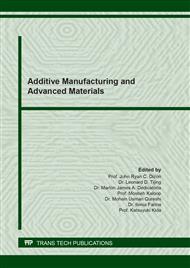[1]
A.-M. Al-Nasri, L.N. Gunawardhana, G.A. Al-Rawas, M.S. Baawain, A. Sana, Multi-layer groundwater flow simulation in Al-Khoud lower catchment in Oman, Https://Doi.Org/10.1080/23249676.2021.1982027. (2021) 1–11. https://doi.org/10.1080/23249676.2021.1982027.
DOI: 10.1080/23249676.2021.1982027
Google Scholar
[2]
R. Sharma, Laboratory study on sustainable use of cement–fly ash–polypropylene fiber-stabilized dredged material, Environ. Dev. Sustain. 20 (2018) 2139–2159. https://doi.org/10.1007/s10668-017-9982-0.
DOI: 10.1007/s10668-017-9982-0
Google Scholar
[3]
P. Jamsawang, S. Charoensil, T. Namjan, P. Jongpradist, S. Likitlersuang, Mechanical and microstructural properties of dredged sediments treated with cement and fly ash for use as road materials, Https://Doi.Org/10.1080/14680629.2020.1772349. 22 (2020) 2498–2522. https://doi.org/10.1080/14680629.2020.1772349.
DOI: 10.1080/14680629.2020.1772349
Google Scholar
[4]
The reduction in shear strength of rocks exposed on slope surfaces due to mechanical weathering is a ubiquitous phenomenon in the regions where extreme environmental conditions prevail ; i . e . repeated change of temperature and moisture . In dealing wit, n.d.
Google Scholar
[5]
M. Le Guern, T.A. Dang, M. Boutouil, Implementation and experimental monitoring of a subgrade road layer based on treated marine sediments, J. Soils Sediments. 17 (2017) 1815–1822. https://doi.org/10.1007/s11368-017-1652-1.
DOI: 10.1007/s11368-017-1652-1
Google Scholar
[6]
N. Yoobanpot, P. Jamsawang, P. Simarat, P. Jongpradist, S. Likitlersuang, Sustainable reuse of dredged sediments as pavement materials by cement and fly ash stabilization, J. Soils Sediments. 20 (2020) 3807–3823. https://doi.org/10.1007/s11368-020-02635-x.
DOI: 10.1007/s11368-020-02635-x
Google Scholar
[7]
R. Zentar, V. Dubois, N.E. Abriak, Mechanical behaviour and environmental impacts of a test road built with marine dredged sediments, Resour. Conserv. Recycl. 52 (2008) 947–954. https://doi.org/10.1016/j.resconrec.2008.02.002.
DOI: 10.1016/j.resconrec.2008.02.002
Google Scholar
[8]
A.K. Jain, A.K. Jha, Shivanshi, Geotechnical behaviour and micro-analyses of expansive soil amended with marble dust, Soils Found. 60 (2020) 737–751. https://doi.org/10.1016/j.sandf.2020.02.013.
DOI: 10.1016/j.sandf.2020.02.013
Google Scholar
[9]
O. Sivrikaya, K.R. Kiyildi, Z. Karaca, Recycling waste from natural stone processing plants to stabilise clayey soil, Environ. Earth Sci. 71 (2014) 4397–4407. https://doi.org/10.1007/s12665-013-2833-x.
DOI: 10.1007/s12665-013-2833-x
Google Scholar
[10]
M.U. Qureshi, B. Al-Sawafi, M. Al-Washahi, M. Al-Saidi, S. Al-Badi, The Sustainable Use of Fine Marble Waste Powder for the Stabilization of Desert Sand in Oman, in: Springer, Cham, 2018: p.303–313. https://doi.org/10.1007/978-3-319-61612-4_25.
DOI: 10.1007/978-3-319-61612-4_25
Google Scholar
[11]
P. Studds, Z.M. Miller, Sustainable material reuse solutions for dredged sediments, Int. J. Sustain. Eng. 3 (2010) 33–39. https://doi.org/10.1080/19397030903380960.
DOI: 10.1080/19397030903380960
Google Scholar
[12]
M. Aziz, I. Towhata, S. Yamada, M.U. Qureshi, Water-submergence effects on geotechnical properties of crushed mudstone, in: Predict. Simul. Methods Geohazard Mitig., 2009: p.291–297. https://doi.org/10.1201/noe0415804820.ch44.
DOI: 10.1201/noe0415804820.ch44
Google Scholar
[13]
M.U. Qureshi, M. Alsaidi, M. Aziz, I. Chang, A.M. Rasool, Z.A. Kazmi, Use of Reservoir Sediments to Improve Engineering Properties of Dune Sand in Oman, Appl. Sci. 2021 (2021) 1620. https://doi.org/10.3390/app11041620.
DOI: 10.3390/app11041620
Google Scholar
[14]
N. Al-Kindi, A. Al-Moqbali, M. Qureshi, A. Al-Shidi, I. Ala-Aldhen, Mechanical characteristics of recycled concrete aggregates as backfill material, Int. J. Appl. Eng. Res. (2016).
Google Scholar
[15]
W.M. Tawfeeq, T.K.M. Ali, Y. Al-Kumzari, M. Al-Hosni, K. Al-Fazari, M. Al-Bedwawi, A. Al-Bashkardi, Flexural performance of reinforced concrete beams made by using recycled block aggregates and fibers, Innov. Infrastruct. Solut. 2020 61. 6 (2020) 1–13. https://doi.org/10.1007/S41062-020-00402-Y.
DOI: 10.1007/s41062-020-00402-y
Google Scholar
[16]
P. Ramanathan, I. Baskar, P. Muthupriya, R. Venkatasubramani, Performance of self-compacting concrete containing different mineral admixtures, KSCE J. Civ. Eng. (2013). https://doi.org/10.1007/s12205-013-1882-8.
DOI: 10.1007/s12205-013-1882-8
Google Scholar
[17]
A.H.L. Swaroop, K. Venkateswararao, Durability Studies On Concrete With Fly Ash & Ggbs, Int J Eng Res Appl. 3 (2013) 285–289. www.ijera.com (accessed July 27, 2021).
Google Scholar
[18]
A.A. Al-Rawas, R. Taha, J.D. Nelson, T.B. Al-Shab, H. Al-Siyabi, A comparative evaluation of various additives used in the stabilization of expansive soils, Geotech. Test. J. 25 (2002) 199–209. https://doi.org/10.1520/gtj11363j.
DOI: 10.1520/gtj11363j
Google Scholar
[19]
K. Al-Jabri, H. Shoukry, I.S. Khalil, S. Nasir, H.F. Hassan, Reuse of Waste Ferrochrome Slag in the Production of Mortar with Improved Thermal and Mechanical Performance, J. Mater. Civ. Eng. 30 (2018) 04018152. https://doi.org/10.1061/(ASCE)MT.1943-5533.0002345.
DOI: 10.1061/(asce)mt.1943-5533.0002345
Google Scholar
[20]
E.A. Adeyanju, C.A. Okeke, Clay soil stabilization using cement kiln dust, IOP Conf. Ser. Mater. Sci. Eng. 640 (2019) 012080. https://doi.org/10.1088/1757-899X/640/1/012080.
DOI: 10.1088/1757-899x/640/1/012080
Google Scholar


